
The Araceae are a family of monocotyledonous flowering plants in which flowers are borne on a type of inflorescence called a spadix. The spadix is usually accompanied by, and sometimes partially enclosed in, a spathe. Also known as the arum family, members are often colloquially known as aroids. This family of 114 genera and about 3,750 known species is most diverse in the New World tropics, although also distributed in the Old World tropics and northern temperate regions.

Cycads are seed plants that typically have a stout and woody (ligneous) trunk with a crown of large, hard, stiff, evergreen and (usually) pinnate leaves. The species are dioecious, that is, individual plants of a species are either male or female. Cycads vary in size from having trunks only a few centimeters to several meters tall. They typically grow slowly and have long lifespans. Because of their superficial resemblance to palms or ferns, they are sometimes mistaken for them, but they are not closely related to either group. Cycads are gymnosperms (naked-seeded), meaning their unfertilized seeds are open to the air to be directly fertilized by pollination, as contrasted with angiosperms, which have enclosed seeds with more complex fertilization arrangements. Cycads have very specialized pollinators, usually a specific species of beetle. Both male and female cycads bear cones (strobili), somewhat similar to conifer cones.
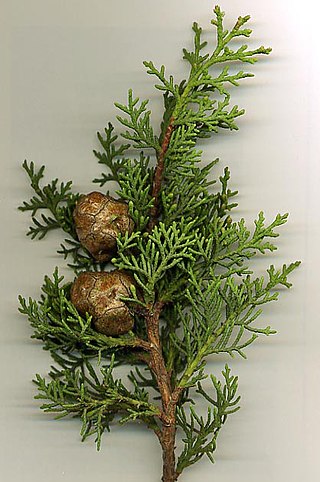
Cupressaceae or the cypress family is a family of conifers. The family includes 27–30 genera, which include the junipers and redwoods, with about 130–140 species in total. They are monoecious, subdioecious or (rarely) dioecious trees and shrubs up to 116 m (381 ft) tall. The bark of mature trees is commonly orange- to red-brown and of stringy texture, often flaking or peeling in vertical strips, but smooth, scaly or hard and square-cracked in some species. The family reached its peak of diversity during the mesozoic era.
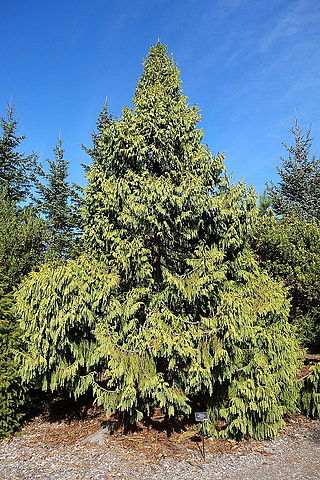
Taiwania, with the single living species Taiwania cryptomerioides, is a large coniferous tree in the cypress family Cupressaceae.
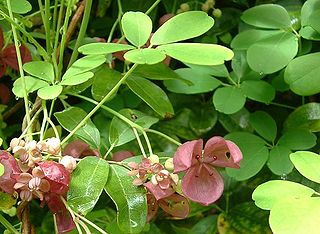
Lardizabalaceae is a family of flowering plants.
Arthurdactylus is a genus of pterodactyloid pterosaur from the Early Cretaceous Crato Formation of northeastern Brazil. It was a medium-sized pterosaur, with a wingspan of 4.5–4.6 metres (14.8–15.1 ft) and body mass of 15 kg (33 lb).

The flora of Australia comprises a vast assemblage of plant species estimated to over 21,000 vascular and 14,000 non-vascular plants, 250,000 species of fungi and over 3,000 lichens. The flora has strong affinities with the flora of Gondwana, and below the family level has a highly endemic angiosperm flora whose diversity was shaped by the effects of continental drift and climate change since the Cretaceous. Prominent features of the Australian flora are adaptations to aridity and fire which include scleromorphy and serotiny. These adaptations are common in species from the large and well-known families Proteaceae (Banksia), Myrtaceae, and Fabaceae.
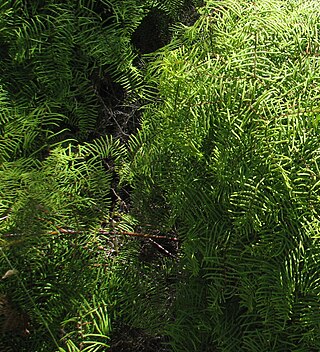
Gleichenia is a genus of ferns. Its closest relative is the genus Stromatopteris, restricted to New Caledonia.

Hylocomiaceae is a family of mosses in the order Hypnales. It includes 14 genera and around 36 species.
Ryszard Ochyra is a Polish bryologist. He has focused on moss systematics of the Southern Hemisphere, specifically in the families Amblystegiaceae, Dicranaceae, Grimmiaceae, and Seligeriaceae. Throughout his career, he has described 48 species of moss considered new to science.

Racomitrium lanuginosum is a widespread species of moss found in montane and arctic tundra, the genus Racomitrium is found across the Northern and Southern hemispheres., however Racomitrium lanuginosum is only found in the Northern hemisphere. It grows as large mats on exposed rock and in boulder scree, particularly on acidic rocks. Its leaves have a characteristically decurrent and toothed hair-point, which gives rise to its regional common names woolly fringemoss, hoary rock-moss and woolly moss.

Racomitrium is a genus of mosses in the family Grimmiaceae established in 1818 by Samuel Elisée Bridel-Brideri. It contains the following species:

Splachnales is an order of Bryophyta or leafy mosses. Along with Orthotrichales, Hedwigiales, and Bryales, it forms the superorder Bryananae.

Bucklandiella is a genus of moss in the family Grimmiaceae.
Bucklandiella elegans is a species of moss in the family Grimmiaceae. It is found in New Zealand.
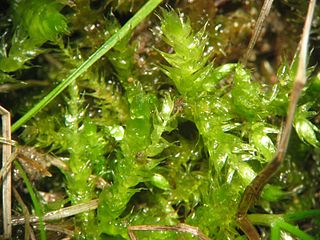
Brachytheciaceae is a family of mosses from the order Hypnales. The family includes over 40 genera and 250 species.

Syntrichia is a large, cosmopolitan genus of mosses in the family Pottiaceae. The genus name is of Greek origin for "with" and "hair", referring to the "twisted peristome united by a basal membrane".

Coscinodon is a genus of mosses belonging to the family Grimmiaceae.
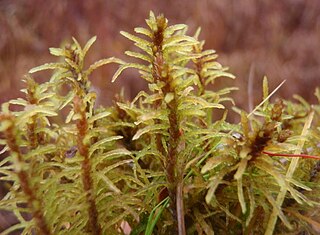
Helodiaceae is a family of mosses belonging to the order Hypnales.
Coscinodon lawianus is a species of moss in the family Grimmiaceae endemic to East Antarctica. It is one of only two species of moss found only in continental Antarctica, out of 23 species found on the continent. It is found on exposed rocks on nunataks and oases scattered across the region, stretching from Queen Maud Land to Princess Elizabeth Land. Initially described as part of the genus Grimmia, it was reclassified into Coscinodon by Polish bryologist Ryszard Ochyra in 2004, owing to similarities with several South American species. C. lawianus is likely a remnant of the Neogene flora of Antarctica which survived the rampant glaciation and cooling of the continent on remote rocky outcrops.















